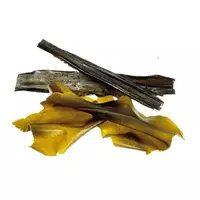Seaweed

Initially, they began to eat algae in Asian countries, but recently, due to the growing popularity of oriental cuisine, Russia has become increasingly interested in this unusual, but very useful product. In addition to a number of edible algae, including fukus, ulva, spirulina, porphyra and many others in Japanese cuisine, 2 types of seaweed are most often used: wakame and kombu. In addition to them, many more Japanese algae are known, which are popular among lovers of oriental cuisine, such as nori, hijiki, kanten and umi budo.
With a sufficiently strong flavor of its own, kombu, for example, is often used as a seasoning that makes the taste of the dish more tender. Wakame is most often an essential component in the preparation of sushi. By the way, in dry form, this species of algae has a dark green, almost black color. After soaking in warm water, they again acquire the original green color and now they can be added to salads or hot dishes.
With seaweed, many types of vegetables are perfectly combined, mainly in raw form. Having prepared, for example, these gifts of the sea with apples, mushrooms or candles, the beneficial properties of algae will not only manifest themselves, but will also multiply. You can make them in an Asian style by toasting in oil and extinguishing, or you can make a cold snack for strong drinks.
Benefits of algae
Not only biologists, but also many doctors argue that in terms of the content of active substances, the benefits of algae exceed the positive effect of all other plant species. This is due to the fact that the quantitative and qualitative content of micro and macronutrients in this product is almost similar to the composition of human blood. Thus, biologically active substances contained in seaweeds have anti-inflammatory and immunomodulatory properties. After numerous studies, the antiviral activity of these substances has also been proven against the human immunodeficiency virus.
Recently, the demand for this food product has increased significantly and is associated with the properties of algae to have a weight loss effect. For example, some algae, like pineapple, contain an enzyme that helps break down fats. Also, when algae are eaten and washed down with water or green tea, they swell in the stomach, increasing in volume, thereby relieving us of hunger for a long time. Plus, the calorie content of algae is very small and is only 2
4. 8 kcal per 100 grams of product, so dishes from these inhabitants of the seabed can be eaten almost without restrictions. The benefits of algae as a dietary product are beyond question.
Harm to algae
Nothing is known to consumers about the harm of algae, therefore, in moderation, this food provides exclusively benefits, having a beneficial effect on the human body.
algae 24.8 kCal
Energy value of algae (Ratio of proteins, fats, carbohydrates - ju):
Proteins: 1.5 g (~ 6 kCal)
Fats: 0 g (~ 0 kCal)
Carbohydrates: 5g (~ 20kCal)
Energy ratio (bj | y): 24% | 0% | 81%
 Español
Español Français
Français Português
Português Русский
Русский 简体中文
简体中文 繁體中文
繁體中文 日本語
日本語 한국어
한국어 العربية
العربية Türkçe
Türkçe Қазақ
Қазақ Deutsch
Deutsch Italiano
Italiano Українська
Українська
